Effect of Microstructure and Tensile Shear Load Characteristics Evaluated by Process Parameters in Friction Stir Lap Welding of Aluminum-Steel with Pipe Shapes
Abstract
:1. Introduction
2. Experimental Preparation and Methods
2.1. Materials and Tools
2.2. Experimental Methods
3. Results and Discussion
3.1. Microstructure Characteristics of Friction Stir Welding (FSW) Joint
3.2. IMC Thickness Characteristics of FSW Joints
3.3. Characteristics of IMC Thickness and Tensile Shear Load (TSL) According to the Tool Penetration Depth (TPD)
3.4. Characteristics of IMC Thickness and TSL According to TRS
4. Conclusions
- As a result of observing the structural change of the cross section after FSW, the average thickness of the IMC layer at the interface between aluminum and steel in the microstructure ranged from 3.4 to 9.05 μm, and the formation of the IMC layer was observed.
- As TPD increased, the average thickness of IMC decreased and TSL increased in the entire experimental area except for the area where TSL decreased at TPD = 0.5 mm or less when WS was 0.1 rpm.
- When WS was 0.1 rpm, TSL increased with increasing IMC thickness at TRS below 1800 rpm, and TSL decreased with decreasing IMC thickness at TRS above 1800 rpm. TSL decreased with increasing IMC thickness as TRS increased when WS was above 0.15 rpm.
- TPD is the dominant factor in the change in size of IMC thickness, and IMC thickness decreases with increasing TPD. TSL increases with decreasing IMC thickness. However, at low WS, when TRS is increased, TSL is affected by TPD, and when TPD increased, TSL was affected by TRS.
Author Contributions
Funding
Institutional Review Board Statement
Informed Consent Statement
Data Availability Statement
Conflicts of Interest
References
- Joo, Y.H.; Park, Y.C.; Lee, Y.M.; Kim, K.H.; Kang, M.C. The Weldability of a Thin Friction Stir Welded Plate of Al5052-H32 using High Frequency Spindle. J. Korean Soc. Manuf. Process Eng. 2017, 16, 90–95. [Google Scholar] [CrossRef]
- Laska, A.; Szkodo, M. Manufacturing Parameters, Materials, and Welds Properties of Butt Friction Stir Welded Joints–Overview. Materials 2020, 13, 4940. [Google Scholar] [CrossRef] [PubMed]
- Park, J.H.; Jeon, S.T.; Lee, T.J.; Kang, J.D.; Kang, M.C. Effect on Drive Point Dynamic Stiffness and Lightweight Chassis Component by using Topology and Topography Optimization. J. Korean Soc. Manuf. Process Eng. 2018, 17, 141–147. [Google Scholar] [CrossRef]
- Hussein, S.A.; Md Tahir, A.S.; Hadzley, A.B. Characteristics of Aluminum-to-Steel Joint Made by Friction Stir Welding: A Review. Mater. Today Commun. 2015, 5, 32–49. [Google Scholar] [CrossRef]
- Ryabov, V.R. Aluminizing of Steel; Oxonian Press: New Delhi, India, 1985. [Google Scholar]
- Wan, L.; Huang, Y. Friction stir welding of dissimilar aluminum alloys and steels: A review. Int. J. Adv. Manuf. Technol. 2018, 99, 1781–1811. [Google Scholar] [CrossRef]
- Thomas, W.M.; Nicholas, E.D.; Needham, J.C.; Murch, M.G.; Temple-Smith, P.; Dawes, C.J. Friction Welding. U.S. Patent 5,460,317B1, 9 December 1997. [Google Scholar]
- Park, J.K.; Kim, Y.S.; Suh, C.H.; Kim, Y.S. Hybrid quenching method of hot stamping for automotive tubular beams. Proc. Inst. Mech. Eng. 2015, 231, 1–12. [Google Scholar] [CrossRef]
- Ducheta, M.; Haouasa, J.; Gibeaub, E.; Pechenota, F.; Honeckera, C.; Muniera, R.; Webera, B. Improvement of the fatigue strength of welds for lightweight chassis application made of Advanced High Strength Steels. Procedia Struct. Integr. 2019, 19, 585–594. [Google Scholar] [CrossRef]
- Sharma, S.R.; Ma, Z.Y.; Mishra, R.S.; Mahoney, M.W. Effect of friction stir processing on fatigue behavior of A356 alloy. Scr. Mater. 2004, 51, 237–241. [Google Scholar] [CrossRef]
- Lee, J.M.; Lee, S.H.; Yoon, J.H.; Kim, K.H. Effects of Melt Treatments on Microstructures and Mechanical Properties of A357 alloy. J. Korea Foundry Soc. 2003, 23, 69–76. [Google Scholar]
- Bouazara, M.; Bouaicha, A.; Ragab, K.A. Fatigue Characteristics and Quality Index of A357 Type Semi-Solid Aluminum Castings Used for Automotive Application. J. Mater. Eng. Perform. 2015, 24, 3084–3092. [Google Scholar] [CrossRef]
- Akbari, M.; Asadi, P. Optimization of microstructural and mechanical properties of friction stir welded A356 pipes using Taguchi method. Mater. Res. Express 2019, 6, 066545. [Google Scholar] [CrossRef]
- Park, J.H.; Park, S.H.; Park, S.H.; Joo, Y.H.; Kang, M.C. Evaluation of Mechanical Properties with Tool Rotational Speed in Dissimilar Cast Aluminum and High-Strength Steel of Lap Jointed Friction Stir Welding. J. Korean Soc. Manuf. Process Eng. 2019, 18, 90–96. [Google Scholar] [CrossRef]
- Choy, L.J.; Park, S.H.; Lee, M.W.; Park, J.H.; Choi, B.J.; Kang, M.C. Tensile Strength Application Using a Definitive Screening Design Method in Friction Stir Welding of Dissimilar Cast Aluminum and High-Strength Steel with Pipe Shape. J. Korean Soc. Manuf. Process Eng. 2020, 19, 98–104. [Google Scholar] [CrossRef]
- Choy, L.; Kim, S.; Park, J.; Kang, M.; Jung, D. Effect of Process Factors on Tensile Shear Load Using the Definitive Screening Design in Friction Stir Lap Welding of Aluminum–Steel with a Pipe Shape. Materials 2021, 14, 5787. [Google Scholar] [CrossRef] [PubMed]
- Forcellese, A.; Simoncini, M.; Casalino, G. Influence of process parameters on the vertical forces generated during friction stir welding of AA6082-T6 and on the mechanical properties of the joints. Metals 2017, 7, 350. [Google Scholar] [CrossRef] [Green Version]
- Wu, C.S.; Zhang, W.B.; Shi, L.; Chen, M.A. Visualization and simulation of the plastic material flow in friction stir welding of aluminium alloy 2024 plates. Trans. Nonferrous Met. Soc. China 2012, 22, 1445–1451. [Google Scholar] [CrossRef]
- Soundararajan, V.; Zekovic, S.; Kovacevic, R. Thermo-mechanical model with adaptive boundary conditions for friction stir welding of Al 6061. Int. J. Mach. Tools Manuf. 2005, 45, 1577–1587. [Google Scholar] [CrossRef]
- Shi, L.; Wu, C.S. Transient model of heat transfer and material flow at different stages of friction stir welding process. J. Manuf. Processes 2017, 25, 323–339. [Google Scholar] [CrossRef]
- Mahto, R.P.; Kumar, R.; Pal, S.K.; Sushanta, K.; Panda, A. comprehensive study on force, temperature, mechanical properties and micro-structural characterizations in friction stir lap welding of dissimilar materials (AA6061-T6 & AISI304). J. Manuf. Processes 2018, 31, 624–639. [Google Scholar] [CrossRef]
- Mishra, R.S.; Ma, Z.Y. Friction stir welding and processing. Mater. Sci. Eng. 2005, 50, 1–78. [Google Scholar] [CrossRef]
- Trimble, D.; O’Donnell, G.E.; Monaghan, J. Characterization of tool shape and rotational speed for increased speed during friction stir welding of AA2024-T3. J. Manuf. Processes 2015, 17, 141–150. [Google Scholar] [CrossRef]
- Rajendran, C.; Srinivasan, K.; Balasubramanian, V.; Balaji, H.; Selvaraj, P. Effect of tool tilt angle on strength and microstructural characteristics of friction stir welded lap joints of AA2014-T6 aluminum alloy. Trans. Nonferrous Met. Soc. China 2019, 29, 1824–1835. [Google Scholar] [CrossRef]
- Liu, X.; Lan, S.; Ni, J. Analysis of process parameters effects on friction stir welding of dissimilar aluminum alloy to advanced high strength steel. Mater. Des. 2014, 59, 50–62. [Google Scholar] [CrossRef]
- Wan, L.; Huang, Y. Microstructure and Mechanical Properties of Al/Steel Friction Stir Lap Weld. Metals 2017, 7, 542. [Google Scholar] [CrossRef] [Green Version]
- Sezhian, M.V.; Giridharan, K.D.; Pushpanathan, P.; Chakravarthi, G.; Stalin, B.; Karthick, A.; Kumar, P.M.; Bharani, M. Microstructural and Mechanical Behaviors of Friction Stir Welded Dissimilar AA6082-AA7075 Joints. Adv. Mater. Sci. Eng. 2021, 13. [Google Scholar] [CrossRef]
- Mahto, R.P.; Bhoje, R.; Pal, S.K.; Joshi, H.S.; Das, S. A study on mechanical properties in friction stir lap welding of AA 6061-T6 and AISI 304. Mater. Sci. Eng. 2016, 652, 136–144. [Google Scholar] [CrossRef]
- Dehghani, M.; Amadeh, A.; Mousavi, S.A. Investigations on the effects of friction stir welding parameters on intermetallic and defect formation in joining aluminum alloy to mild steel. Mater. Des. 2013, 49, 433–441. [Google Scholar] [CrossRef]
- Iqbal, M.P.; Vishwakarma, R.K.; Pal, S.K.; Mandal, P. Influence of plunge depth during friction stir welding of aluminum pipes. Proc. Inst. Mech. Eng. Part B J. Eng. Manuf. 2020, 1–12. [Google Scholar] [CrossRef]
- Iqbal, M.P.; Jain, R.; Pal, S.K. Numerical and experimental study on friction stir welding of aluminum alloy pipe. J. Mater. Process. Technol. 2019, 274, 116258. [Google Scholar] [CrossRef]
- El-Kassas, A.M.; Sabry, I.; Mourad, A.-H.I.; Thekkuden, D.T. Characteristics of Potential Sources—Vertical Force, Torque and Current on Penetration Depth for Quality Assessment in Friction Stir Welding of AA 6061 Pipes. Int. Rev. Aerosp. Eng. 2019, 12, 195–204. [Google Scholar] [CrossRef]
- Wei, Y.; Li, J.; Xiong, J.; Zhang, F. Effect of Tool Pin Insertion Depth on Friction Stir Lap Welding of Aluminum to Stainless Steel. J. Mater. Eng. Perform. 2013, 22, 3005–3013. [Google Scholar] [CrossRef]
- Shen, Z.; Chen, Y.; Haghshenas, M.; Gerlich, A.P. Role of welding parameters on interfacial bonding in dissimilar steel/aluminum friction stir welds. Eng. Sci. Technol. Int. J. 2015, 18, 270–277. [Google Scholar] [CrossRef] [Green Version]
- Mahto, R.P.; Pal, S.K. Friction stir lap welding of thin aa6061-t6 and aisi304 sheets at different values of pin penetrations. In International Manufacturing Science and Engineering Conference; American Society of Mechanical Engineers: New York, NY, USA, 2018; Volume 51364. [Google Scholar] [CrossRef]
- Jamshidi Aval, H.; Falahati Naghibi, M. Orbital friction stir lap welding in tubular parts of aluminium alloy AA5083. Sci. Technol. Weld. Join. 2017, 22, 562–572. [Google Scholar] [CrossRef]
- Herbst, S.; Aengeneyndt, H.; Maier, H.J.; Nürnberger, F. Microstructure and mechanical properties of friction welded steel-aluminum hybrid components after T6 heat treatment. Mater. Sci. Eng. 2017, 696, 33–41. [Google Scholar] [CrossRef]
- Lan, S.; Liu, X.; Ni, J. Microstructural evolution during friction stir welding of dissimilar aluminum alloy to advanced high-strength steel. Int. J. Adv. Manuf. Technol. 2016, 82, 2183–2193. [Google Scholar] [CrossRef]
- Coelho, R.S.; Kostka, A.; Dos Santos, J.F.; Kaysser-Pyzalla, A. Friction-stir dissimilar welding of aluminium alloy to high strength steels: Mechanical properties and their relation to microstructure. Mater. Sci. Eng. 2012, 556, 175–183. [Google Scholar] [CrossRef]
- Haghshenas, M.; Abdel-Gwad, A.; Omran, A.M.; Gökçe, B.; Sahraeinejad, S.; Gerlich, A.P. Friction stir weld assisted diffusion bonding of 5754 aluminum alloy to coated high strength steels. Mater. Des. 2014, 55, 442–449. [Google Scholar] [CrossRef]
- Mahto, R.P.; Anishetty, S.; Sarkar, A.; Mypati, O.; Pal, S.K.; Majumdar, J.D. Interfacial Microstructural and Corrosion Characterizations of Friction Stir Welded AA6061-T6 and AISI304 Materials. Met. Mater. Int. 2019, 25, 752–767. [Google Scholar] [CrossRef]
- Shamsujjoha, M.; Jasthi, B.K.; West, M.; Widener, C. Friction stir lap welding of aluminum to steel using refractory metal pin tools. J. Eng. Mater. Technol. 2015, 137, 021009. [Google Scholar] [CrossRef]
- Ma, Z.Y.; Sharma, S.R.; Mishra, R.S. Microstructural Modification of As-Cast Al-Si-Mg Alloy by Friction Stir Processing. Metall. Mater. Trans. 2006, 37, 3323–3336. [Google Scholar] [CrossRef]
- Springer, H.; Kostka, A.; Payton, E.J.; Raabe, D.; Kaysser-Pyzalla, A.; Eggeler, G. On the formation and growth of intermetallic phases during interdiffusion between low-carbon steel and aluminum alloys. Acta Mater. 2011, 59, 1586–1600. [Google Scholar] [CrossRef]
- Haidara, F.; Record, M.C.; Duployer, B.; Mangelinck, D. Phase formation in Al–Fe thin film systems. Intermetallics 2012, 23, 143–147. [Google Scholar] [CrossRef]
- Movahedi, M.; Kokabi, A.H.; Reihani, S.S.; Najafi, H. Mechanical and microstructural characterization of A1-5083/St-12 lap jointsmade by friction stir welding. Procedia Eng. 2011, 10, 3297–3303. [Google Scholar] [CrossRef] [Green Version]
- Sepold, G.; Kreimeyer, M. Joining of dissimilar materials. In Proceedings of the First International Symposium on High-Power Laser Macroprocessing. International Society for Optics and Photonics, Bellingham, WA, USA, 27–31 May 2003; Volume 4831, pp. 528–533. [Google Scholar]
- Jiang, W.H.; Kovacevic, R. Feasibility study of friction stir welding of 6061-T6 aluminium alloy with AISI 1018 steel. Proc. Inst. Mech. Eng. Part B J. Eng. Manuf. 2004, 218, 1323–1331. [Google Scholar] [CrossRef]
- Das, H.; Basak, S.; Das, G. Influence of energy induced from processing parameters on the mechanical properties of friction stir welded lap joint of aluminum to coated steel sheet. Int. J. Adv. Manuf. Technol. 2013, 64, 1653–1661. [Google Scholar] [CrossRef]
- Kundu, S.; Roy, D.; Bhola, R.; Bhattacharjee, D.; Mishra, B.; Chatterjee, S. Microstructure and tensile strength of friction stir welded joints between interstitial free steel and commercially pure aluminium. Mater. Des. 2013, 50, 370–375. [Google Scholar] [CrossRef]
- Das, H.; Jana, S.S.; Pal, T.K.; De, A. Numerical and experimental investigation on friction stir lap welding of aluminium to steel. Sci. Technol. Weld. Join. 2014, 19, 69–75. [Google Scholar] [CrossRef]
- Lee, C.Y.; Choi, D.H.; Yeon, Y.M.; Jung, S.B. Dissimilar friction stir spot welding of low carbon steel and Al–Mg alloy by formation of IMCs. Sci. Technol. Weld. Join. 2009, 14, 216–220. [Google Scholar] [CrossRef]
- Kimapong, K.; Watanabe, T. Lap joint of A5083 aluminum alloy and SS400 steel by friction stir welding. Mater. Trans. 2005, 46, 835–841. [Google Scholar] [CrossRef] [Green Version]
- Picot, F.; Gueydan, A.; Martinez, M.; Moisy, F.; Hug, E. A correlation between the ultimate shear stress and the thickness affected by intermetallic compounds in friction stir welding of dissimilar aluminum alloy–stainless steel joints. Metals 2018, 8, 179. [Google Scholar] [CrossRef] [Green Version]
- Helal, Y.; Boumerzoug, Z. Dissimilar friction stir welding of Al-6061 to steel. In Proceedings of the AIP Conference Proceedings; AIP Publishing LLC.: Melville, NY, USA, 2016; Volume 1772, p. 030008. [Google Scholar]
- Aghajani Derazkola, H.; García, E.; Eyvazian, A.; Aberoumand, M. Effects of Rapid Cooling on Properties of Aluminum-Steel Friction Stir Welded Joint. Materials 2021, 14, 908. [Google Scholar] [CrossRef] [PubMed]
- Mortello, M.; Pedemonte, M.; Contuzzi, N.; Casalino, G. Experimental Investigation of Material Properties in FSW Dissimilar Aluminum-Steel Lap Joints. Metals 2021, 11, 1474. [Google Scholar] [CrossRef]
- Pankaj, P.; Tiwari, A.; Biswas, P. Impact of varying tool position on the intermetallic compound formation, metallographic/mechanical characteristics of dissimilar DH36 steel, and aluminum alloy friction stir welds. Weld. World 2021, 66, 239–271. [Google Scholar] [CrossRef]
- Abd Elnabi, M.M.; Osman, T.A.; El Mokadem, A.; Elshalakany, A.B. Evaluation of the formation of intermetallic compounds at the intermixing lines and in the nugget of dissimilar steel/aluminum friction stir welds. J. Mater. Res. Technol. 2020, 9, 10209–10222. [Google Scholar] [CrossRef]
- Sabry, I.; Zaafarani, N. Dry and Underwater Friction Stir Welding of aa6061 Pipes—A Comparative Study; Materials Science and Engineering Series; IOP Publishing: Bristol, UK, 2021; Volume 1091, p. 012032. [Google Scholar]
- Abdullah, M.E.; Elmetwally, H.T.; Yakoub, N.G.; Elsheikh, M.N.; Abd-Eltwab, A.A. Effect of orbital friction crush welding parameters on aluminum tubes. Int. J. Sci. Technol. Res. 2020, 9, 4483–4486. [Google Scholar]
- Su, J.Q.; Nelson, T.W.; Sterling, C.J. Microstructure evolution during FSW/FSP of high strength aluminum alloys. Mater. Sci. Eng. 2005, 405, 277–286. [Google Scholar] [CrossRef]
- Ogura, T.; Nishida, T.; Nishida, H.; Yoshida, T.; Omichi, N.; Hirose, A. Partitioning evaluation of mechanical properties and the interfacial microstructure in a friction stir welded aluminum alloy/stainless steel lap joint. Scr. Mater. 2012, 66, 531–534. [Google Scholar] [CrossRef]

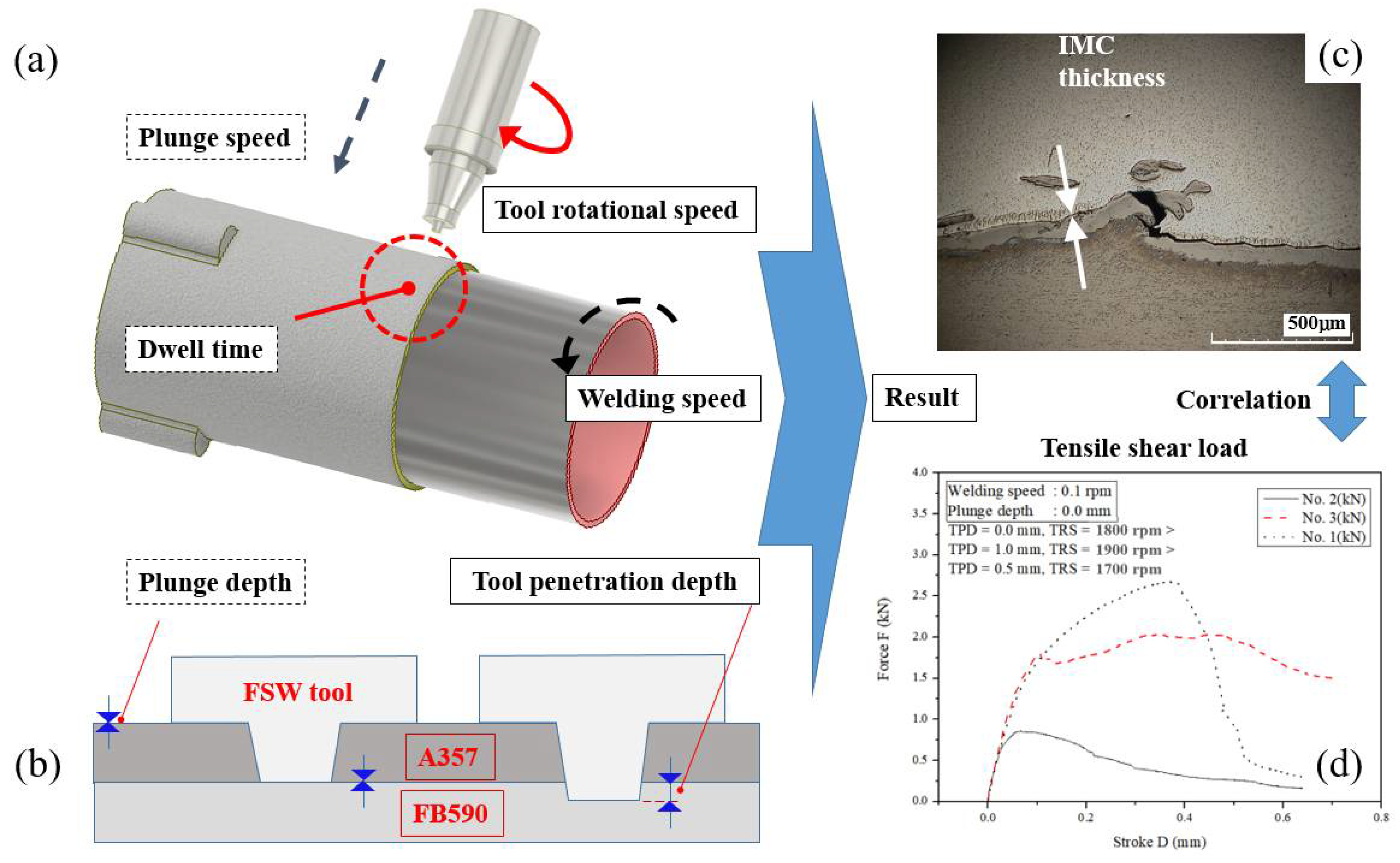

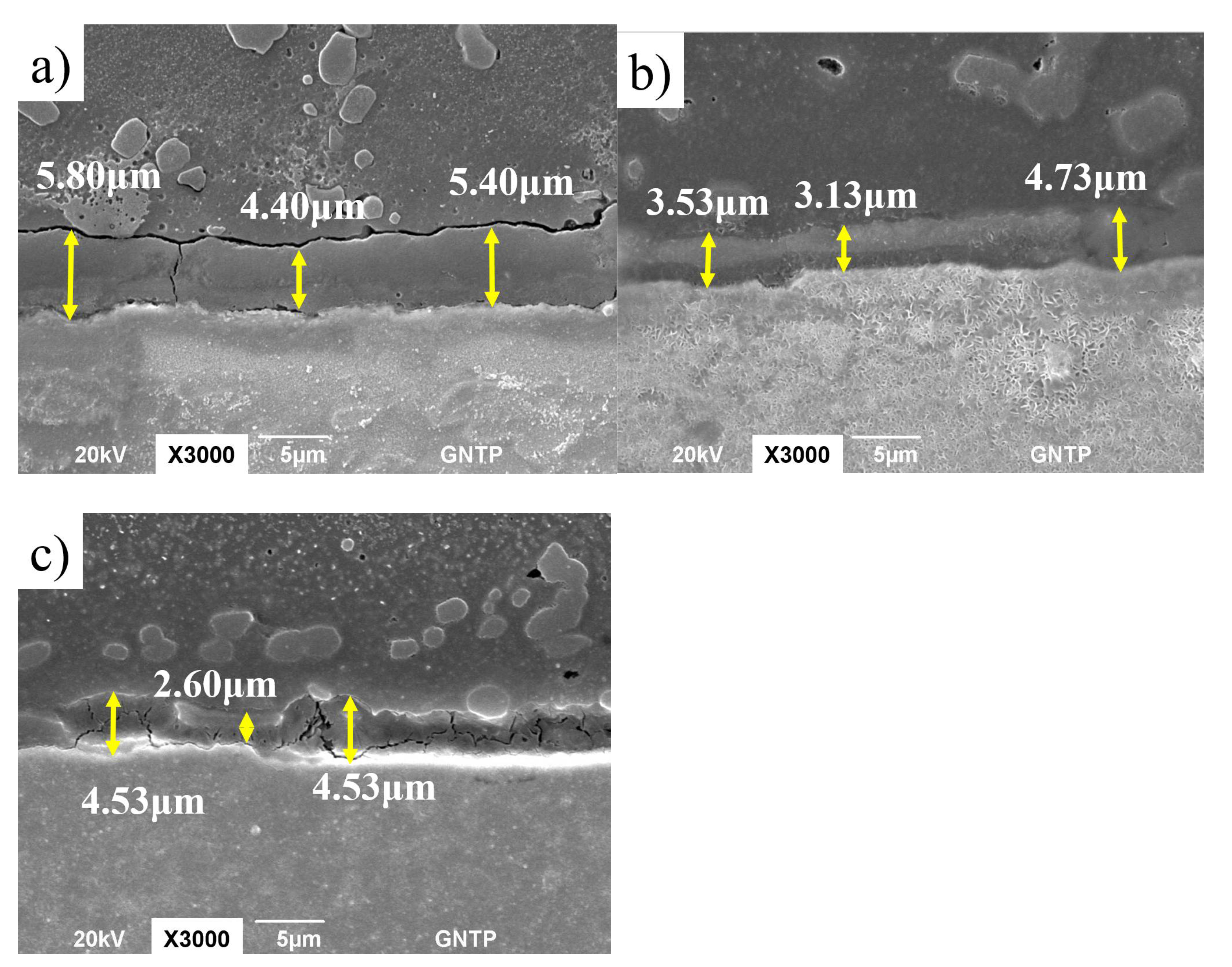
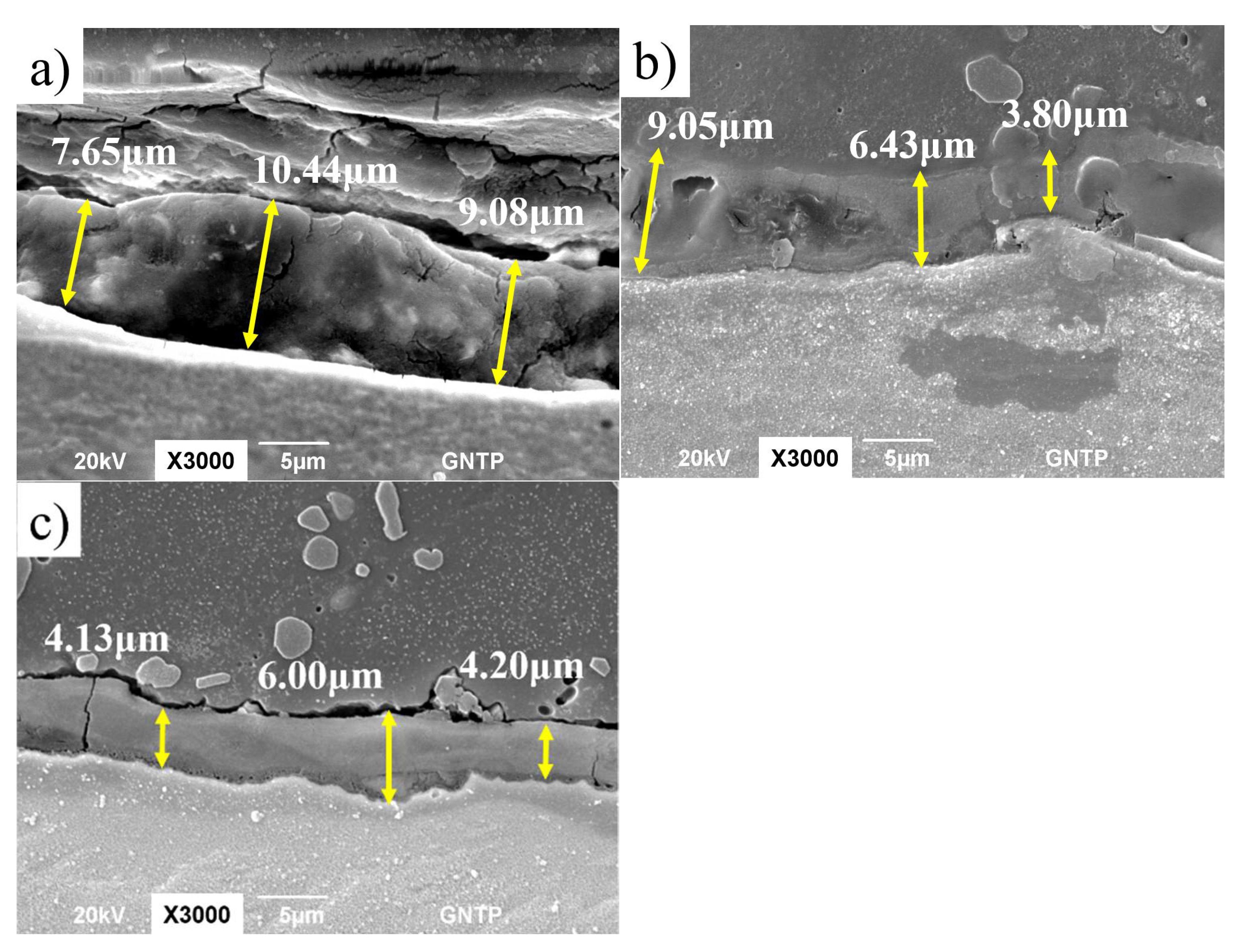
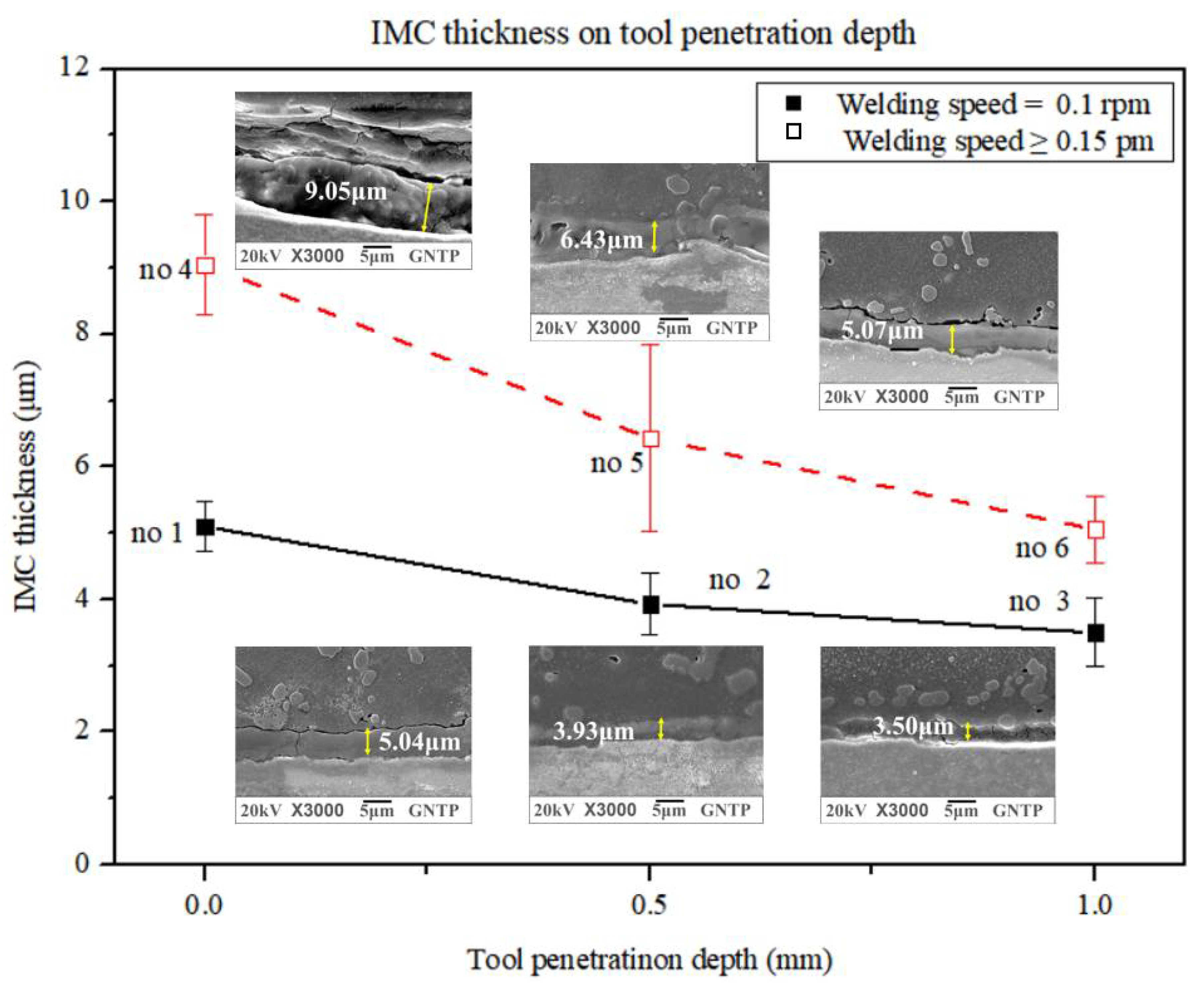
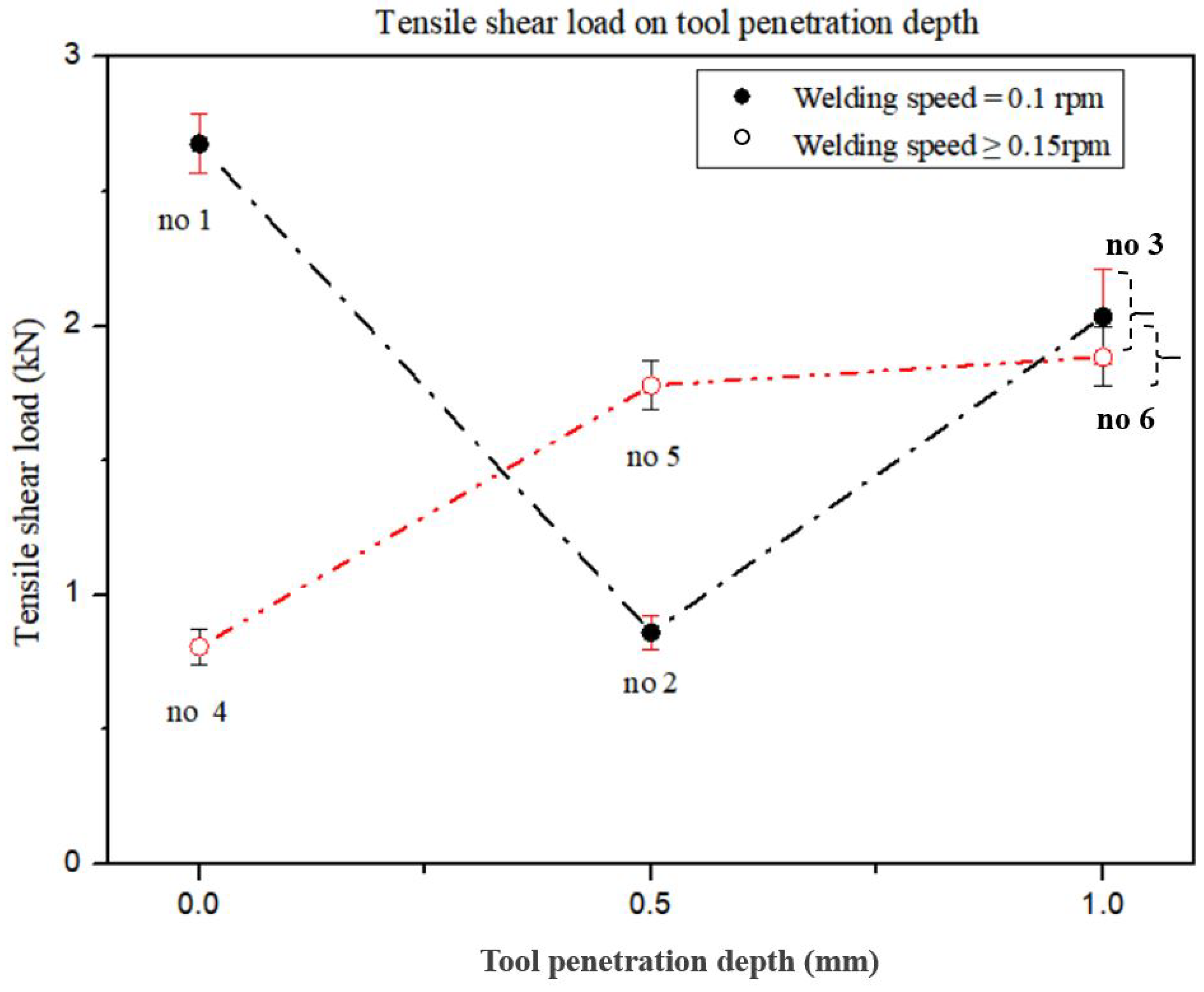
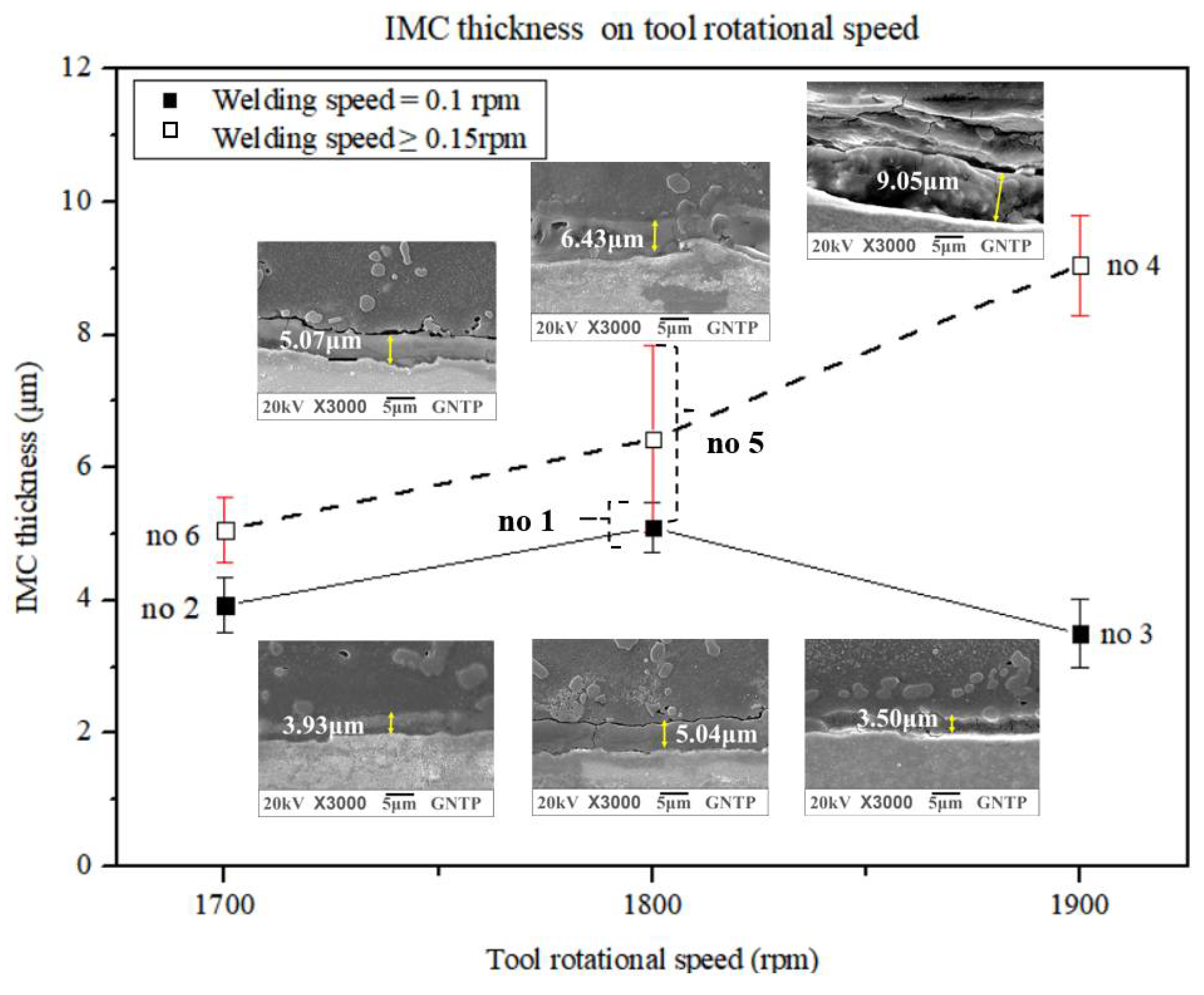
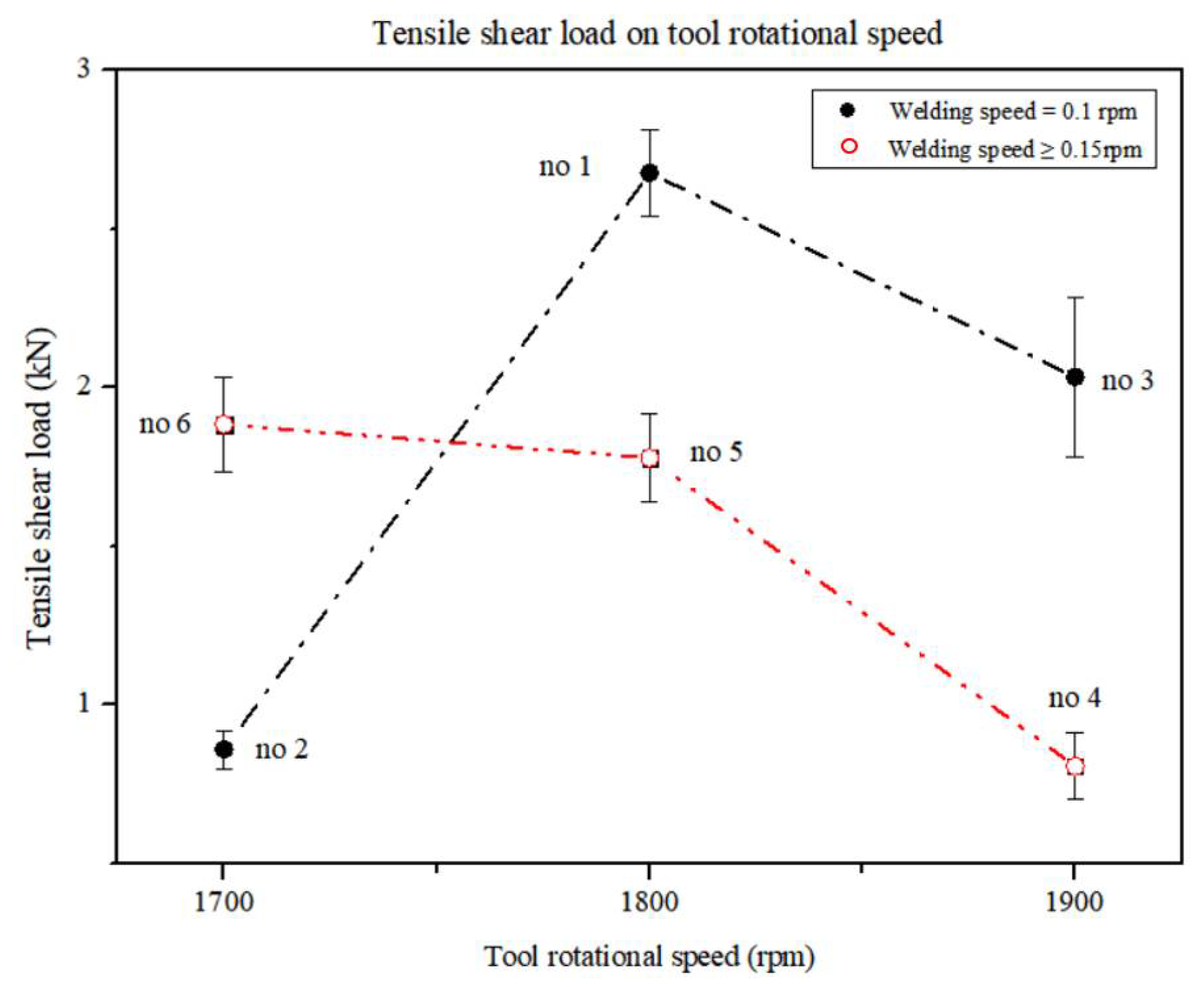
| Material | C | Si | Mn | P | S | Cr | Ni |
|---|---|---|---|---|---|---|---|
| FB590 | 0.076 | 0.094 | 1.472 | 0.013 | 0.001 | 0.019 | 0.008 |
| Material | Si | Mg | Cu | Zn | Fe | Mn | Ti |
| A357 | 6.937 | 0.507 | 0.034 | 0.017 | 0.181 | 0.007 | 0.116 |
| Experiment No. | Welding Speed (rpm) | Tool Penetration Depth (mm) | Tool Rotational Speed (rpm) |
|---|---|---|---|
| 1 | 0.10 | 0.0 | 1800 |
| 2 | 0.10 | 0.5 | 1700 |
| 3 | 0.10 | 1.0 | 1900 |
| 4 | 0.20 | 0.0 | 1900 |
| 5 | 0.15 | 0.5 | 1800 |
| 6 | 0.20 | 1.0 | 1700 |
| Experiment No. | 1 | 2 | 3 | 4 | 5 | 6 |
|---|---|---|---|---|---|---|
| Tool penetration depth (mm) | 0.0 | 0.5 | 1.0 | 0.0 | 0.5 | 1.0 |
| IMC thickness range (µm) | 5.80–4.40 | 4.73–3.13 | 4.53–2.60 | 10.44–7.65 | 9.05–3.80 | 6.00–4.13 |
| IMC average thickness (µm) | 5.04 | 3.93 | 3.56 | 9.05 | 6.43 | 5.07 |
| Tensile shear load (N) [16] | 2677.21 | 860.50 | 2034.83 | 807.35 | 1779.25 | 1984.72 |
| Experiment No. | 2 | 1 | 3 | 6 | 5 | 4 |
|---|---|---|---|---|---|---|
| Tool rotational speed (rpm) | 1700 | 1800 | 1900 | 1700 | 1800 | 1900 |
| IMC thickness range (µm) | 4.73–3.13 | 5.80–4.40 | 4.53–2.60 | 6.00–4.13 | 9.05–3.80 | 10.44–7.65 |
| IMC average thickness (µm) | 3.93 | 5.04 | 3.56 | 5.07 | 6.43 | 9.05 |
| Tensile shear load (N) [16] | 860.50 | 2677.21 | 2034.83 | 1984.72 | 1779.25 | 807.35 |
Publisher’s Note: MDPI stays neutral with regard to jurisdictional claims in published maps and institutional affiliations. |
© 2022 by the authors. Licensee MDPI, Basel, Switzerland. This article is an open access article distributed under the terms and conditions of the Creative Commons Attribution (CC BY) license (https://creativecommons.org/licenses/by/4.0/).
Share and Cite
Choy, L.; Kang, M.; Jung, D. Effect of Microstructure and Tensile Shear Load Characteristics Evaluated by Process Parameters in Friction Stir Lap Welding of Aluminum-Steel with Pipe Shapes. Materials 2022, 15, 2602. https://doi.org/10.3390/ma15072602
Choy L, Kang M, Jung D. Effect of Microstructure and Tensile Shear Load Characteristics Evaluated by Process Parameters in Friction Stir Lap Welding of Aluminum-Steel with Pipe Shapes. Materials. 2022; 15(7):2602. https://doi.org/10.3390/ma15072602
Chicago/Turabian StyleChoy, Leejon, Myungchang Kang, and Dongwon Jung. 2022. "Effect of Microstructure and Tensile Shear Load Characteristics Evaluated by Process Parameters in Friction Stir Lap Welding of Aluminum-Steel with Pipe Shapes" Materials 15, no. 7: 2602. https://doi.org/10.3390/ma15072602
APA StyleChoy, L., Kang, M., & Jung, D. (2022). Effect of Microstructure and Tensile Shear Load Characteristics Evaluated by Process Parameters in Friction Stir Lap Welding of Aluminum-Steel with Pipe Shapes. Materials, 15(7), 2602. https://doi.org/10.3390/ma15072602








